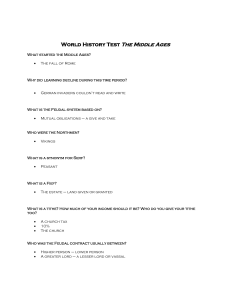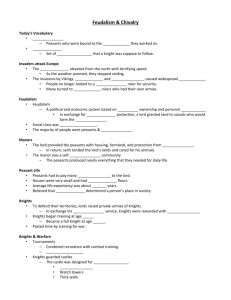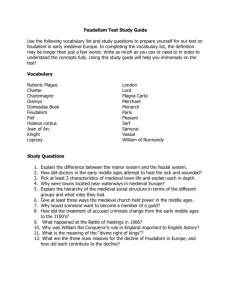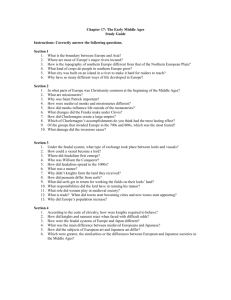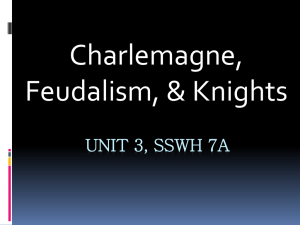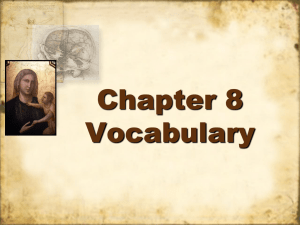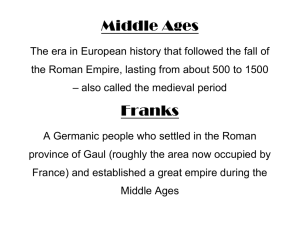feudalism
advertisement
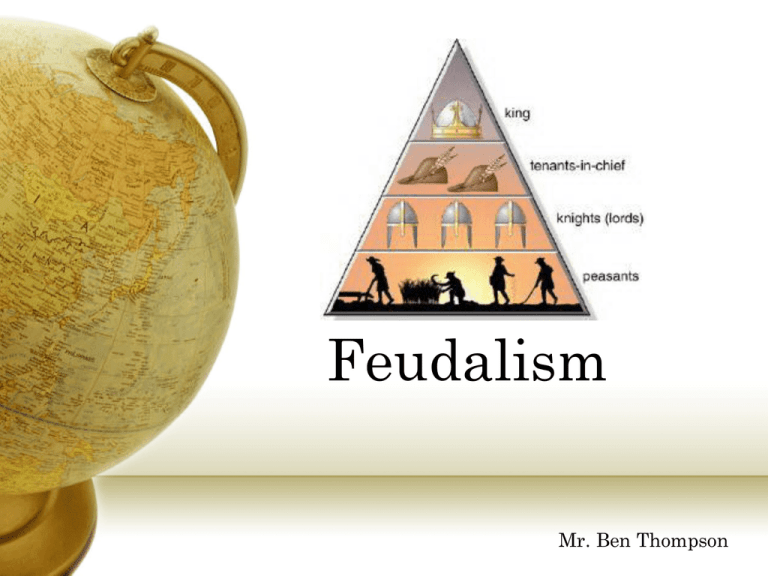
Feudalism Mr. Ben Thompson What would it be like to be a serf? •Click here to find out! Europe in the year 1000 A.D. The Setting: • Despite this political, linguistic and cultural diversity, there were some elements which gave unity to the European continent: • Religion and the written culture. The religion practiced throughout the continent was Christianity. • Trade, led to the exchange of something more important than goods: ideas. Difficult Living Conditions • • • The living conditions of the European population around the year 1000 were very tough. Life expectancy was short and those who surpassed the age of 40 were regarded as old people. Mortality was very high. Wars were numerous, diseases were frequent and there were no efficient remedies to fight them. The population lived on the products they cultivated and any disaster -such as droughts and floods- caused great famine. More than half of the newborn children died before their first year and many women died in childbirth. Unsafe Medieval Times • • • • During the 9th and 10th centuries, the European continent was the target of new waves of invaders. The Normans or Vikings originated in Scandinavia and settled in the British Isles and Atlantic coasts. The Magyars from the steppes created a kingdom in Hungary. The Slavs, from the Russian plains, settled in eastern Europe and the Balkans. The Slavs The Magyars The Vikings Medieval Society • • • • • Medieval society was organized into three groups: nobles, knights and peasants. Nobles were people who were born into wealthy families and/or owned large sums of land. Clergymen, included in the ranks of nobility, were monks and priests. They prayed to guarantee the spiritual salvation of the people. Knights were the owners of weapons, and their mission was to protect the rest of the population in the event of an attack. Peasants and other workers were in charge of producing food and necessary objects. Serfs were the lowest of the low. They were slaves. Knights • • • • Not all the knights had the same wealth and power. There were small, modest knights and rich, powerful knights. Knights were linked through vassalage. This consisted mainly of a ceremony in which both the lord and the vassal took part. The vassal paid homage to the lord, that is to say, pledged fidelity; the vassal was required for life to help and support the lord, especially in military conflicts. The lord committed himself to protect the vassal and house him in his dwellings or give him a castle or territory. This donation was called a fief, the term which feudalism derives from. Find out more about knights! Peasants & Serfs • • • Peasants were dependant on a lord (knight or clergyman), who administered justice, charged fines and collected taxes. The peasants had to pay for the use of the mill, presses, forges and kilns which were the lord’s property. However, all peasants were not alike. Most of the peasants were serfs, that is to say, they depended on a lord or monastery and could not leave the lands where they had been born. They worked the lands of the lord without remuneration, and they had to give the lord part of their own harvest or a rent. Other peasants were free. They owned the lands they worked on and did not have to pay for them. A Medieval Village Christianity During the Middle Ages • In Europe during the Middle Ages the only recognized religion was Christianity, in the form of the Catholic religion. The lives of the Medieval people of the Middle Ages were dominated by the church. From birth to death, whether you were a peasant, a serf, a noble a lord or a King - life was dominated by the church. Various religious institutions became both important, rich and powerful. The lives of many Medieval people were dedicated to the Catholic church and religion. These are all detailed in the following links all of which relate to Middle Ages Religion. Thanks for watching! Now click here to take the quiz! Feudalism Quiz 1. What is the term for the piece of land that is awarded to a knight for his brave service to a noble? 2. What is the term for a peasant who is bound to his land? 3. Who is at the top of the feudal totem pole? 4. Who was the leader of the medieval church? 5. Name one group of people that invaded medieval Europe. Click here for the answers. Quiz Answers 1. 2. 3. 4. 5. Fief Serf King Pope Vikings, Magyars, or Slavs Vikings! Sources: http://www.britainexpress.com/History/Feudalism_a nd_Medieval_life.htm http://www.historyonthenet.com/Medieval_Life/feud alism.htm http://www.fidnet.com/~weid/feudalism.htm http://www.mrdowling.com/703-feudalism.html http://www.historiasiglo20.org/MEC-BC/2-6-1.htm What would it be like to be a serf?
